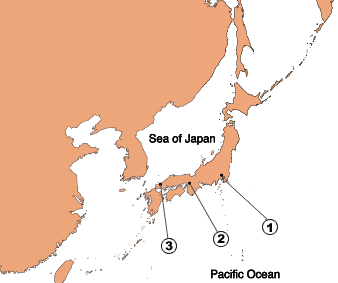|
|
|
NIPPONIA No.27 December 15, 2003
|
|
Japan Travelogue |
 |
(1)Tokyo
(2)Osaka
(3)Hagi |
|
Hagi is situated on the Sea of Japan, in northern Yamaguchi Prefecture at the western tip of Japan's largest island, Honshu. It developed as a castle town at the mouth of the Abu-gawa River, which flows to the sea from the southeast. The quiet streets are bordered by white clay walls and wooden fences. The local people seem to lead an unhurried life — it is hard to believe that this small, tranquil castle town was the home of men who at once time upset the existing political order and laid the foundation for modern Japan.
Well before then, in the 16th century, the Mori family controlled a large part of western Japan, including Hagi. But in 1600, the Mori were defeated at the Battle of Sekigahara, and their domain was greatly reduced in size, leaving them only the westernmost part of the island of Honshu. A castle was built in Hagi in 1604.
About 250 years later, the Tokugawa Shogunate in Edo (present-day Tokyo) began losing control, and foreign powers started mounting pressure on Japan. Reacting to the crisis, a number of young men in Hagi developed ideas that were revolutionary for the times. Some fought against the military forces of the Shogunate and of foreign countries, and then formed a group that was influential in reforming and modernizing the country through the Meiji Restoration. Hagi gave birth to some of the ideals that helped create modern Japan.
The many historic buildings in the old section of Hagi seem to be part of a living museum. When you walk from the ruins of Hagi Castle toward the city center, you will pass through the old district where the Mori family and their chief vassals lived. The lanes are lined with tall clay walls painted white. One of them, called Toida Masuda-shi Kyu-taku Dobei (clay garden wall of the former Toida Masuda residence), is 130 meters long. A long wooden housing complex, called Kyu Asa Mori-ke Hagi Yashiki Nagaya (former Asa Mori Hagi tenement house), is typical of the homes of the important samurai who lived here. In places, streets still have sharply-angled twists and turns, laid out to prevent any enemy who invaded the town from going directly to the castle.
A little east from there, old houses stand side by side. Some were built by samurai of medium rank, others by rich merchants. The Kikuya-ke Jutaku residence is one of the oldest merchant houses still standing, and it has given its name to the street, Kikuya Yokocho. On this street, buildings have beautiful namako-kabe exterior walls, decorated with tiles and plaster joints. Inside, you will get an idea of how the rich merchants of long ago lived, and how they decorated their homes with works of art like byobu screens and kakejiku hanging scrolls. In this district still stand houses where young revolutionaries like Takasugi Shinsaku and Kido Takayoshi were born and lived. Those days still seem real today, so real that it almost feels like their youthful voices are drifting over the walls from some nearby house.
The Abu-gawa River forks into two streams, one called Matsumoto-gawa River. Cross it and continue east, and you will come to Shoka Sonjuku, a small private academy started by Yoshida Shoin, Hagi's most famous revolutionary. The one-story wooden building is tiny, only about 50 square meters in area, but many people came here and absorbed new ideas. More than a few went on to build modern Japan, including the above-mentioned Takasugi and Kido, and two men who later became prime ministers in the new government system, Ito Hirobumi and Yamagata Aritomo.
Just north of the old academy is a quiet shrine called Shoin-jinja, which is dedicated to the memory of Yoshida Shoin. If you walk east from there for about 10 minutes you will come to Toko-ji Temple, built in honor of the Mori lords. More than 500 stone lanterns stand in orderly rows, creating a magnificently solemn atmosphere.
Hagi is also known for its pottery industry, begun at the end of the 16th century by artisans from the Korean peninsula. Hagi ware is among the most famous in Japan. Hagi's tea ceremony bowls are considered to be among the very best — there is a saying, Ichi Raku, ni Hagi, san Karatsu ("Raku bowls are best, Hagi's are second, and Karatsu's third"). Hagi ware developed to a high standard because of the technical expertise of the potters, the excellent clay found in the area, and the support the Mori family gave by promoting the industry.
At Hagi-yaki Kaikan, you can try your hand at the potter's wheel. Asked what makes Hagi ware so special, Okafuji Tetsuhiko replied: "It's the tiny cracks that we call kannyu. When you use a bowl, moisture and tea deposits enter the cracks, changing the color of the bowl over time. We have a saying, 'Hagi no nana bake,' which means, 'Hagi ware keeps changing its appearance, time after time.' The more you use it, the more refined it looks. That's the nice thing about Hagi ware."
In Hagi, you almost feel you are back in the Edo period (1603-1867), even when strolling past ordinary houses. In early summer, the branches of the natsu mikan trees, heavy with citrus fruit, peek over the clay walls along the streets. Come and enjoy the mild climate and the people, who have an equally mild temperament. History lives on, casting a spell you are sure to enjoy as you stroll through Hagi.
|
|
||||||||
|
||||||||
|